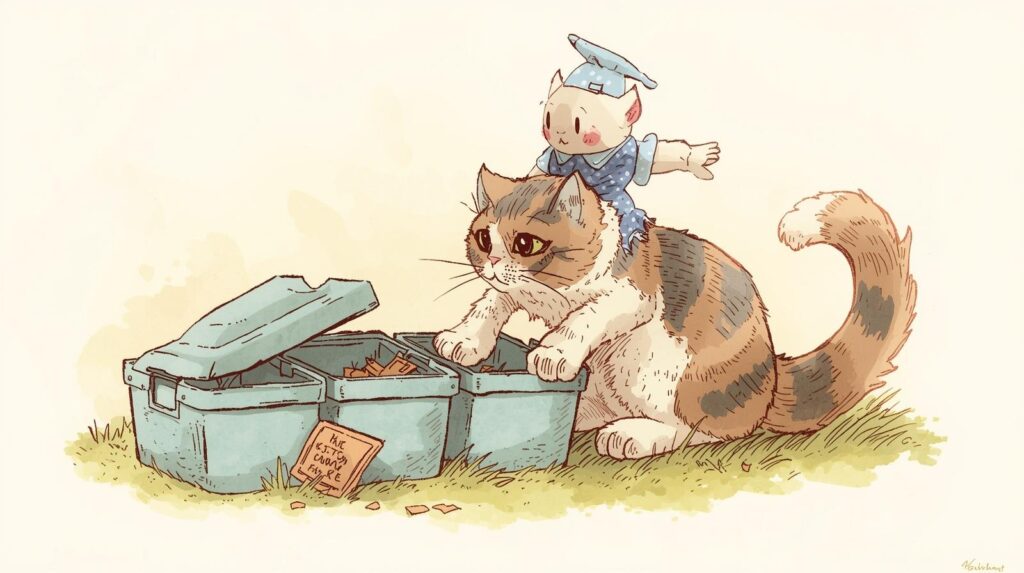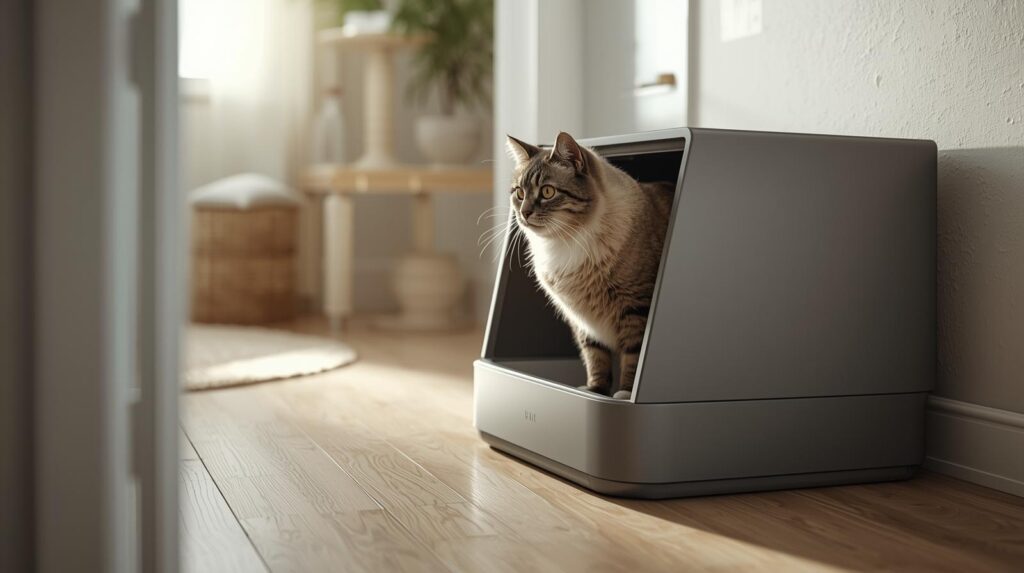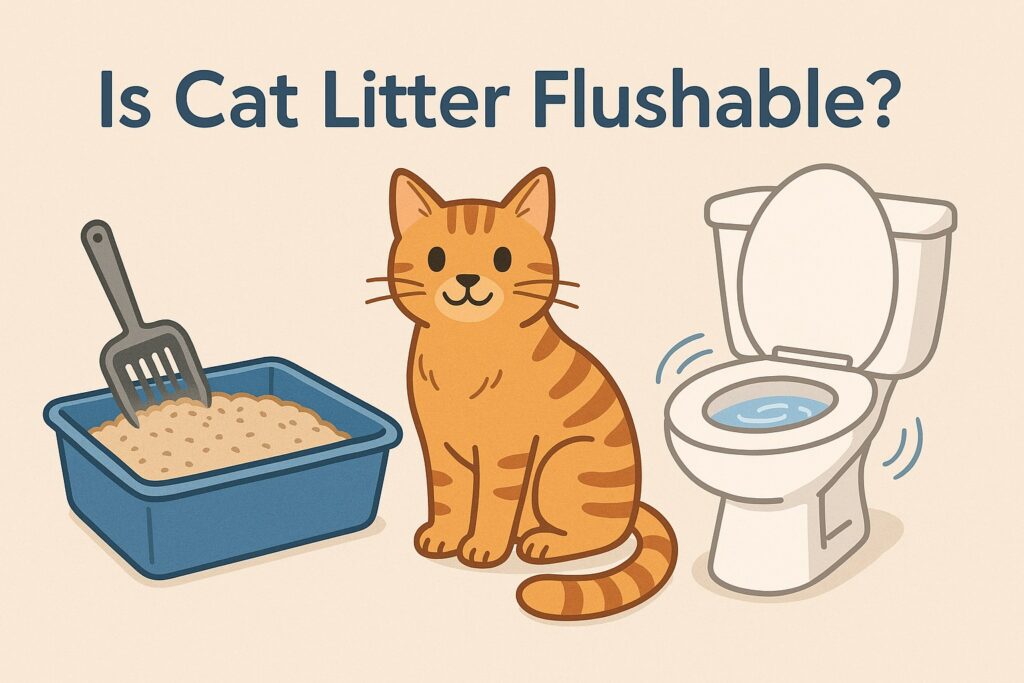
Many cat litter brands today advertise themselves as flushable, making it sound like a quick and eco-friendly solution. After all, flushing waste down the toilet seems more convenient than bagging it and throwing it in the trash. But is that really safe for your home plumbing, septic system, and the environment?
Is cat litter flushable? The direct answer: No, most cat litters are not truly flushable, and even those marketed as “flushable” come with serious risks. They may cause clogged pipes, damage septic systems, or spread harmful parasites into waterways. Before you ever flush litter, it’s important to understand the real dangers behind this common marketing claim.
Table of Contents
Can You Flush Cat Litter?
No, flushing cat litter is not recommended. While some brands may claim their product is flushable, most types of litter cause more harm than convenience. Clay and clumping litters are the worst offenders because they expand when they come into contact with water, creating cement-like clogs in pipes and drains.
Silica crystal litters also cannot be flushed since they are not biodegradable and can build up inside plumbing systems. Even plant-based litters such as corn, wheat, paper, or tofu are risky—though they’re marketed as flushable, frequent flushing still leads to blockages and costly plumbing issues.
Beyond the mechanical problems, flushing cat feces introduces another danger: it can spread Toxoplasma gondii, a parasite harmful to both humans and wildlife, through wastewater systems.
Why Flushing Cat Litter Is Unsafe
Flushing cat litter might seem harmless, but it creates major plumbing and wastewater problems. Bentonite clay litters swell dramatically when wet, turning into a sticky paste that can block pipes and drains within your home. Even so-called flushable litters are not truly safe—when they reach a septic tank, they can overload the system, settle at the bottom, and lead to backups or costly repairs.
Municipal sewer systems are also not designed to handle litter particles, meaning they can cause clogs and slowdowns in wastewater treatment facilities. This is why most plumbers strongly warn against flushing any type of litter, no matter the brand.
The Health Risk — Toxoplasmosis and Water Pollution
Beyond plumbing concerns, flushing cat feces poses a serious public health and environmental risk. Cat waste may carry Toxoplasma gondii, a parasite that survives wastewater treatment and can contaminate rivers, lakes, and oceans.
Once in the water, it harms wildlife—especially sea otters, seals, and other marine animals. Some U.S. states have even issued warnings or restrictions against flushing cat feces because of this threat. For cat owners, this means flushing litter isn’t just a household risk—it’s an environmental one too.
Flushable Cat Litter Brands — Are They Really Flushable?
Many brands—especially those made from tofu, corn, wheat, or recycled paper—are marketed as “flushable.” The idea sounds appealing, but in reality, these litters are only safe in tiny amounts, and even then, they often lead to plumbing problems over time.
Plumbers frequently report calls from homeowners dealing with clogged pipes caused by so-called flushable litter.
While brand packaging or SDS sheets may claim safety for flushing, independent experts and environmental authorities warn against it because of the risks to both plumbing and ecosystems. The truth is: flushable litter is not a reliable solution, especially if you use it daily.
What Happens If You Flush Cat Poop?
Flushing cat poop directly is unsafe. Even without the litter, cat feces can still clog pipes, overload septic systems, and spread parasites such as Toxoplasma gondii. This parasite survives standard wastewater treatment and ends up polluting waterways, harming marine life.
For those living in apartments, the risks are even higher—many landlords and property managers forbid flushing pet waste because of costly sewer backups. In some regions, flushing cat poop is not just discouraged but explicitly illegal due to environmental hazards.
Is Flushable Cat Litter Safe for Septic Tanks?
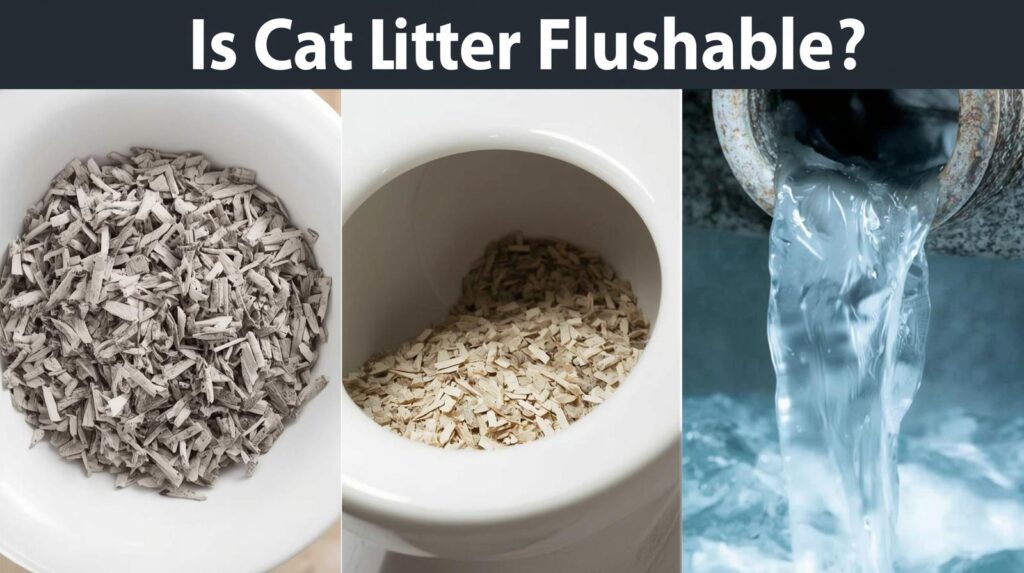
No, flushable cat litter is not safe for septic tanks. Even when marketed as “septic safe,” litters can build up inside the system over time. Septic tanks are designed to handle only human waste and toilet paper—nothing more. When cat litter clumps enter the tank, they can block filters, reduce system efficiency, and lead to backups that require costly pumping or repairs.
Over time, even small amounts of litter may create serious septic problems, making flushing an expensive mistake.
Biodegradable vs Flushable — What’s the Difference?
Many cat owners confuse biodegradable and flushable, but they are not the same thing. Biodegradable litter is made from natural materials (corn, wheat, pine, paper, tofu) and breaks down over time in a compost bin or landfill. Flushable litter, on the other hand, is marketed as dissolving in water so it can be flushed—but in practice, it rarely breaks down completely and often clogs pipes.
This confusion is a major content gap: just because a litter is biodegradable does not mean it’s safe to flush. Composting or disposing of it in the trash is always safer than sending it down the toilet.
Best Alternatives to Flushing (Safe Disposal Methods)
The safest way to dispose of cat litter is not flushing, but proper trash or compost methods:
- Bag and trash → Scoop the used litter into a sturdy bag (preferably a biodegradable one if you’re eco-conscious) and place it in the garbage.
- Compost → Only suitable for plant-based litters (wood, wheat, paper, corn). Never use composted cat litter in food gardens due to the risk of parasites.
- Pet waste bins → Some municipalities provide specialized pet waste disposal bins—these are a safe and eco-friendly option.
- Never burn litter → Burning cat litter creates harmful smoke and dust, especially from clay or silica products.
Environmental Impact of Flushing Cat Litter
Flushing cat litter isn’t just bad for your pipes — it harms the environment, too.
- Wastewater plants can’t filter parasites. If cat feces contain Toxoplasma gondii, it can pass through treatment plants and end up in rivers and oceans. This parasite has been linked to the decline of sea otters, seals, and other marine wildlife.
- Flushable litter fibers don’t break down fully. Many so-called flushable litters (corn, wheat, paper) release organic sludge that builds up in water systems. Some even add microplastic-like particles (from packaging residues or clay traces), polluting waterways.
- The hidden cost: Flushing may feel “eco-friendly,” but the environmental footprint is often worse than simply bagging and tossing litter into the trash.
Regional Laws & Warnings
Not all regions treat cat litter disposal the same way. In fact, flushing is outright discouraged or restricted in some places.
- California & Washington State (USA): Both have issued warnings against flushing cat feces because of the toxoplasmosis risk to marine wildlife.
- Other U.S. states: Some city sewer authorities explicitly say “Do NOT flush cat litter” in local guidelines.
- UK & EU: While not always illegal, flushing pet waste is discouraged due to wastewater treatment limitations.
Plumber Insights & Case Studies
Even when litters are marketed as “flushable,” plumbers see the real-world results.
- Clogged pipes: Plumbers report frequent calls from households that flushed “septic-safe” litter, only to find hardened clumps in the U-bend or deeper in the sewer line.
- Septic backups: Flushable litter can accumulate in septic filters, leading to costly pumping or full system repairs.
- Case study: A plumber in Seattle noted that “most of the flushable litters I’ve removed behave exactly like cement once inside the pipes.”
Cat Litter & Water Bills / Hidden Costs
Flushing may seem convenient, but the financial risks far outweigh the time saved:
- Septic repair costs: $300–$800 for a pumping, or $3,000–$10,000+ for a failed drain field.
- Clog removal fees: A single plumber visit to clear a clogged toilet or sewer line can cost $150–$500.
- Water treatment strain: Municipal utilities may pass higher costs onto taxpayers if litter increases sludge or filtration loads.
Brand Call-Outs — Are They Really Flushable?
Some cat litter brands promote “flushable” formulas, but real-world results are mixed.
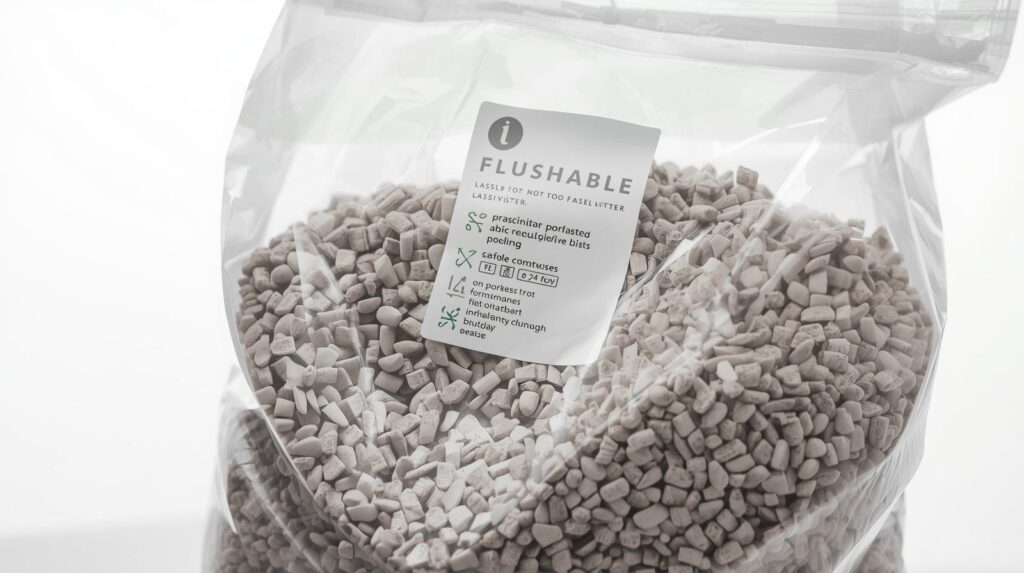
- World’s Best Cat Litter (corn-based): Marketed as flushable, but plumbers report frequent clogs if used daily. Safe only in tiny amounts.
- ökocat (wood/paper): Breaks down better than clay but still risks clogging older pipes and septic filters.
- sWheat Scoop (wheat-based): Flushable claims exist, but over time it behaves like dough in plumbing systems.
- Feline Pine (pine-based): Some formulas say flushable, but many users report swelling pellets that don’t fully dissolve.
Storage & Safety Tips for Cat Litter Disposal
- Store unused litter in a dry area away from moisture.
- Never mix litter with chemicals, ashes, or cleaning products before disposal.
- If experimenting with “flushable” litter, use in tiny amounts only and be prepared for possible clogs.
- Always scoop and dispose of litter daily to prevent odor and bacteria buildup.
Myth-Busting FAQs About Flushable Cat Litter
Is all flushable litter really flushable?
No. Even so-called flushable litters often clog pipes or damages septic tanks.
Can you flush just the poop without litter?
Still not recommended. Cat feces may carry Toxoplasma gondii, which survives water treatment and harms wildlife.
Is flushing cat poop illegal?
Yes, in some states and regions, it is explicitly banned due to parasite risks and water pollution.
What’s the safest litter for plumbing?
None. No litter type should go into toilets—trash or compost are the only safe options.
Why do brands market flushable litter if it isn’t safe?
Marketing often exaggerates convenience, but plumbers and environmental agencies strongly advise against flushing.
Does flushable litter dissolve in water?
Not fully—clumps, fibers, or granules often remain intact and can build up in pipes.
Is biodegradable cat litter the same as flushable?
No. Biodegradable means it breaks down in nature; flushable means it’s marketed to dissolve in water—but the two terms are not interchangeable.
Can flushable litter damage septic systems over time?
Yes. Even if it doesn’t clog immediately, it can build up in septic tanks, leading to costly repairs.
Are compostable litters safe for gardens?
Only for ornamental plants, not food gardens, due to parasite contamination risk.
What do plumbers say about flushable litter?
Most plumbers report that flushable litter is one of the top causes of preventable toilet and septic clogs.

